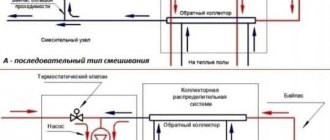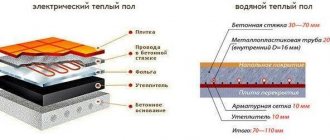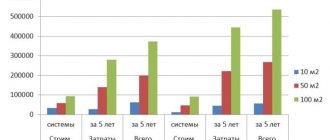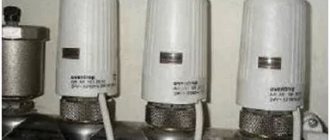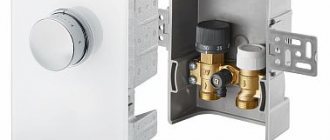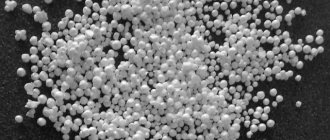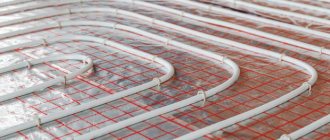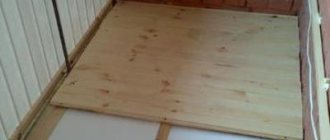During the cold season, you want to create a favorable atmosphere in your home, and for this it is recommended to install a heated floor. Using polystyrene foam for heated floors means maintaining a comfortable temperature in the room. It is believed that polystyrene is flammable, but this material has many more positive properties. After reading the article to the end, you will learn more about the use of PPP in construction.
It increases sound insulation and does not put pressure on the floors. Even a beginner can lay lightweight slabs with his own hands. In addition, there are several ways to lay polystyrene; it can also be used for a warm water floor under a screed.
Expanded polystyrene for heated floors: types of EPS
The production of expanded polystyrene began a long time ago, and the technology for creating the material has survived to this day. The basis for the plates is styrene filled with gas. The resulting mass is heated so that the styrene granules increase in volume and stick together. This happens in special forms. There is another way, when the mass is passed through an extruder.
There are several types of expanded polystyrene, differing in quality and basic properties. Polystyrene is:
- Pressed. Since the granules are connected to each other under pressure from the press, the slabs are especially dense and strong. This species is not produced on a mass scale, since the technology is expensive. They use pressed polystyrene foam only in military affairs, and make it to special order;
- Pressless suspension. A common type, but it is suitable mainly for household use. It is especially good for insulating walls from the outside. When purchasing pressless insulation, it is important to pay attention to its quality and technical properties. In low-grade slabs, the granules are not identical in size. If the material has a low density, you should not use it as insulation;
- Pressless self-extinguishing. This type differs from the previous one only in its non-flammability, otherwise the technology is almost identical. To obtain an improved version, special substances are added to the styrene mass during production;
- Extruded polystyrene foam is most suitable for heated floors. The material can be used for laying on a concrete floor under a screed without fear. Extruded polystyrene is durable and dense, does not allow water to pass through and does not ignite. The production technology of extruded polystyrene foam allows it to be used in a wide variety of types of construction work.
Pressless and pressed PPS has a shelf life of about 40 years. Its technical properties do not change. The shelf life of extruded polystyrene is twice as long.
Foamed polystyrene foam and its competitors
Of the insulation materials currently used in construction, almost all are applicable for the installation of underfloor heating systems. However, there are reservations that suspend the desire of professional and independent builders to buy and install:
- cork insulation, the price of which suggests looking for a more affordable alternative;
- mineral wool, which is overly sensitive to the action of groundwater, which is why its use in floor structures on the ground and above an unheated underground is highly undesirable;
- foamed polyethylene with or without a foil shell - a material that decreases three times in thickness under the weight of the screed;
- granular and pressed foam plastic, which is attractive due to its cost and insulating qualities, but does not have sufficient rigidity.
Let us note that granulated and pressed foam plastic for heated floors is quite suitable material if the load is not intended to be distributed over it. Those. There is nothing cheaper and more practical to find for installing heating equipment in the construction of a wooden floor with joists and a cold subfloor.
In general terms, the scheme for constructing a heated floor with foam plastic or crumbly polystyrene insulation will look like this:
- The free space between the joists installed on a plank or plywood base is filled with polystyrene granules or cut foam boards.
- The insulation is covered with a vapor barrier membrane on top, then an additional sheathing is built across the joists to ensure ventilation.
- Plywood or similar sheet material is attached to the sheathing.
- Install guides from slats, between which the heated floor loops will be laid.
- Further in accordance with the budget. Either 30 micron thick foil is laid only along the path of water floor pipes or electrical cables, or it is completely covered with foiled polyethylene. Or metal profiled guides, produced specifically for wooden heated floors, are installed between the slats.
After laying pipes or cables, the structure is covered with plywood, OSB boards, GVLV sheets according to the rules of dry screed, and then the coating is laid. By default, we assume that this structure is protected from ground moisture and condensation by waterproofing on the underground side or that it already existed under a plank or plywood sub-base.
Attention. Despite the assurances of most manufacturers that polystyrene foam and granulated styrene are insensitive to moisture, waterproofing is imperative. Otherwise, moisture penetrating into the pores and spaces between the granules will significantly reduce the insulating qualities of the insulation.
It is very advisable to protect the material from the basement side with a fine metal mesh from rodents. Polystyrene does not cause appetite in them, but you should not give them the opportunity to taste it.
A special reflective underlay promotes uniform heat distribution over the floor surface and actually speeds up the heating of the system. It is very important to choose the right material for different systems. Let us help you figure it out here: .
How to choose polystyrene?
Expanded polystyrene becomes a favorite among floor insulation especially often, but you need to be able to choose the right material, prepared strictly according to technology. First, you should pay attention to the appearance of the slabs.
All extruded polystyrene beads must fit tightly together and not peel off or have any defects. If some granules are larger than others, it means that the manufacturing technology has been violated. High-quality slabs are always uniform in color without streaks or stains. If the manufacturing technology is followed, extruded polystyrene foam for floor insulation will not have a strong unpleasant odor.
You should not purchase polystyrene foam for underfloor heating from dubious sellers. The packaging must indicate its technical properties and information about the manufacturer. There can be no damage to the packaging of a quality product. It is dangerous to buy slabs for construction in illegal places. Since not all types of polystyrene are safe, you need to be sure you are purchasing a quality product for your floors.
Features of expanded polystyrene
Expanded polystyrene is considered the best thermal insulation material; with its help you can get a warm floor, but also make the base rigid and durable.
Expanded polystyrene has all the qualities of polystyrene foam, but it is even better because it has a dense structure with cells that are smaller in size. The main advantages of expanded polystyrene:
- the insulation has high moisture resistance and the ability to not allow steam to pass through. This makes it possible to maintain thermal conductivity at the desired level, even if exposed to moisture;
- this material can provide good sound insulation, and this is an important condition when insulating a floor system;
- the material is absolutely safe for people and environmentally friendly;
- the insulation will not allow fungus and mold to develop;
- expanded polystyrene is resistant to chemicals;
- performance properties are maintained even with large temperature changes;
- With this material you can quickly install the floor.
The main advantage is that the material is absolutely safe, it does not burn and has the ability to quickly fade.
We recommend: Operating principle of heated floors
Advantages and disadvantages of expanded polystyrene
Expanded polystyrene has its pros and cons, so before making a choice in favor of this insulation, you need to know its advantages and disadvantages. The advantages include high noise-reducing properties, as well as durability. It does not allow water to pass through, does not rot and is not subject to fungi.
Polystyrene can last a very long time, and in comparison with other insulation for underfloor heating, it is considered a budget option. It can only deteriorate at critical temperatures, which are rare. But its technical properties have their own characteristics.
Some types of EPS can catch fire, but polystyrene foam for heated floors is extruded, and it is not afraid of fire. The greatest danger to the material is mechanical damage to the slabs. But if you lay extruded polystyrene foam under a warm floor, it will be safe. It is recommended to lay thermal insulation under the screed, then the room will retain heat better.
Advantages
When using extruded EPS boards you will get a lot of advantages, including:
- Easy installation . The instructions for laying slabs do not require you to have special tools, special skills, knowledge or abilities. Almost everyone can handle laying thermal insulation with their own hands;
Installation of a heated floor with polystyrene foam insulation does not require special skills.
- Qualitative geometry . Plates from reputable manufacturers (TechnoNIKOL, Penoplex, URSA, etc.) are distinguished by their correct geometry and high-precision milling of edges, locks, bosses and other elements;
Expanded polystyrene slabs have the correct geometry, which eliminates heat loss.
- Soundproofing . In addition to cutting off the ceiling from heating, the foam layer will provide sound insulation sufficient to prevent neighbors below from hearing the gurgling of water in the system pipes;
The foam mat will provide sound insulation.
- Affordable price . Compared to other options, such as balsa wood, polyurethane foam or foam glass, the cost of PPP is quite affordable and differs significantly;
- High efficiency . The material copes well with its responsibilities and ensures almost complete absence of heat loss;
The photo shows the L-edge, which significantly increases the thermal insulation efficiency.
- No smell . High-quality polystyrene boards do not emit odors. The material can be confidently laid in a bedroom or other room without fear of smelling a chemical aroma;
- Additional moisture protection . The material is completely waterproof and has a very low vapor permeability coefficient. Thanks to this, your floor will be additionally protected from moisture coming from below, and your neighbors will be protected from flooding.
The structure of the heated floor system.
Insulation of concrete floors with granules
Expanded polystyrene for a warm concrete floor can be added directly to the solution and this mixture can be used for screeding. This interesting technology allows you to give the screed all the positive properties of PPS. Concrete does not allow noise to pass through, and the surface becomes especially warm. But a large number of balls reduces strength, so it is important to maintain a balance when using this method.
Technology for preparing concrete mortar with granules:
- Add some water to the cement;
- Start mixing the concrete solution;
- Without stopping stirring, add polystyrene foam;
- Achieve a uniform consistency.
The amount of granules must be determined independently, but it is recommended to use them at least 3 times more than the concrete solution, otherwise the thermal conductivity of the floors will be low. The floor covering is selected relative to the final rigidity of the screed made of concrete and EPS balls.
What kind of base is it placed on?
Floor insulation with extruded polystyrene foam // FORUMHOUSE
Expanded polystyrene is an affordable type of thermal insulation; it contributes to the normal functioning of the “warm floor” system. The material can be laid on various substrates:
- sand-crushed stone - obtained by compacting soil;
- gravel - which is compacted and protected from moisture;
- concrete - equipped with a waterproofing coating;
- wooden - flooring with waterproofing.
For your information! It is forbidden to use mixtures containing solvent or bitumen mastic as a waterproofing layer on the base of polystyrene; under their influence, the insulation may be destroyed.
Preparing floors for concrete screed
You can lay the insulation directly on the concrete floor and then fill it with screed. This method of thermal insulation of heated floors under a screed is also suitable for laying on joists, although it will be slightly different.
Any work with heated floors must begin with the elimination of the old coating. The surface must be cleaned down to the concrete base. All debris and dust must also be removed, otherwise the screed solution will not lie evenly.
The prepared floor must be treated with a primer, and then wait until it dries. If it turns out that the floors have large differences, you will have to use a mixture to level the surface.
When the surface is leveled and dry, you can use a screed. You cannot continue laying polystyrene foam right away; you should wait two days for the filling solution to set well.
Types of thermal insulation
Penofol
Penofol is produced and sold in the form of rolls.
Penofol is foil-coated polyethylene foam. It is a soft and flexible material produced in rolls.
Thermal conductivity coefficient is 0.037 – 0.052 W/m×°C.
Penofol is easy to install and easy to cut. The foil layer effectively distributes heat over the entire surface of the heated floor.
However, this material also has a drawback: under the weight of the screed and floor covering, it can shrink, while the volume of air bubbles included in its structure will significantly decrease, which will entail a loss of thermal insulation qualities.
Important! As a rule, this material is used on the upper floors of apartment buildings, where there is a warm heated room under the heated floor, and the floor slab is sufficiently heated. . This material is not suitable for basements and first floors, as well as balconies and loggias, basements and garages.
Sometimes, however, it is not possible to raise the floor a significant distance, then the use of penofol may be justified.
This material is not suitable for basements and first floors, as well as balconies and loggias, basements and garages. Sometimes, however, it is not possible to raise the floor a significant distance, then the use of penofol may be justified.
Advice! When choosing floor insulation, look for foil materials with an aluminum foil thickness of at least 30 microns. We are not interested in lavsan coatings with reflective properties, only thick foil!
Cork tree
Balsa wood insulation is sold in rolls, sometimes in the form of mats or slabs.
The thermal conductivity of balsa wood ranges from 0.035 – 0.05 W/m×°C. As you can see, this characteristic is comparable to that of penofol.
However, it is believed that a layer of cork 2–3 mm thick is sufficient to insulate a heated floor. This is certainly a controversial opinion.
The advantage of cork insulation is its naturalness. It consists of absolutely natural raw materials and does not emit toxic chemicals under any conditions.
However, there are also disadvantages:
- high price of material;
- the possibility of rotting, a breeding ground for fungi and mold;
- damage from biological corrosion;
- the cork needs waterproofing.
Therefore, for cork wood we can also conclude that it is only suitable for floors with minor losses and warm heated floors. More often, cork is used as a substrate for laminate flooring.
Expanded polystyrene
Foiled polystyrene foam for thermal insulation of floors with markings.
Expanded polystyrene is the most acceptable option for thermal insulation of floors.
This is caused by a number of reasons:
- The material has a density sufficient for laying under the screed - more than 35 kg/m³;
- Expanded polystyrene slabs have sufficient thickness - 50 mm, thanks to which you can easily arrange effective 100 mm thermal insulation of the floors of basements and basements, first floors, etc.;
- The material has low thermal conductivity - 0.039 W/m×°C, which with a layer of 50 - 115 mm provides complete insulation and reduces heat loss to nothing;
- Expanded polystyrene for floors is covered with a laminated layer of foil from 30 microns thick, which makes this type of insulation optimal;
- The installation instructions suggest simple DIY work, and markings on the foil make it easier to install the heating elements;
- The slabs do not shrink under the weight of the screed and maintain stable thermal conductivity for many years;
- Polystyrene is chemically inert to solutions of salts, acids and alkalis;
- The material is biologically inactive and is not food for living organisms or a substrate for fungi;
- Does not change parameters and does not emit harmful chemicals in the temperature range from – 180 to +180 ° C.
Advice! When purchasing a thermal insulator based on polystyrene foam, look for flooring material, since facade and other configurations may not be suitable for working near heating elements and emit harmful substances or change their parameters and shape.
Expanded polystyrene is especially convenient for warm water floors if it is equipped with special locks for securing the tubes.
Important! According to most experts, it is extruded polystyrene foam with a density of 35 kg/m³ that is the best means of thermal insulation for heated floors, especially on the ground floors and in the case of unheated rooms below.
Laying PPS on a concrete base
After 2 days, damper tape should be glued along the perimeter along the walls, and then a film should be stretched over the entire surface, serving as waterproofing. If you ignore this step and do not use film, the insulation will deteriorate over time. The waterproofing must be laid with an overlap so that there are no gaps left for moisture to penetrate. It is recommended to go slightly beyond the line of the walls.
Next comes floor insulation with extruded polystyrene foam. It is necessary to take extruded material with high density. The technical properties of the slabs are especially important for this installation method. If the slabs are larger than required, they must be cut into several pieces.
Features of installation of a polystyrene heated floor system
For a polystyrene heated floor system, the base floor must be level. There should be no changes, slopes, or elevations. The evenness of the floor can be checked against the light. This is due to the fact that the load perceived by the floor is distributed over large surfaces of polystyrene slabs. The slabs will “play” on uneven surfaces, which will undoubtedly lead to distortion of the entire system, and as a result, the thermodynamics of the entire system will deteriorate.
The grooves in the slabs are made in increments of 150 or 300 mm. Therefore, pipes can only be installed with this step.
When installing a polystyrene heated floor system, you must not forget
- Place a vapor barrier (plastic film) on the base floor;
- Lay damper tape around the perimeter of the room;
- Before closing (finishing) the pipeline, check (pressure test) the entire system.
At the end of the article there are several conclusions.
Insulation of floors along joists
Expanded polystyrene for heated floors can be laid along joists. This method is easier and faster. First, wooden logs need to be prepared. To do this, they are treated with special anti-fungal preparations and are also covered with moisture protection.
Thermal insulation on joists is only suitable if the joists are located on a concrete base.
Construction of a polystyrene heated floor system
Any underfloor heating system consists of three functional main parts.
- heating element
- Heating element control systems
- Layers of coatings on which the heating element is laid and covered.
The heating element of the polystyrene underfloor heating system is hot water circulating in metal-plastic water pipes. In principle, a polystyrene heated floor system is a water heated floor laid on a special covering of polystyrene slabs.
The technology for laying insulation is as follows:
- Cleaning and cleaning the surface, removing rotten wooden elements. Leveling floors, if required;
- Laying waterproofing. The best option is plastic film. Be sure to overlap. The joints of the waterproofing parts must be taped with tape;
- Installation of lag. When determining the distance between the lags, you need to focus on the dimensions of extruded polystyrene foam. To secure wooden logs to the slab, you need to drill holes in them in advance and then attach them with fasteners;
- Laying polystyrene. Slabs of the required size are placed between the joists. If necessary, the material can be trimmed;
- Fixation of vapor insulation;
- Installation of durable coating. This is not the floor finish, but the slabs on which it will be installed. They can be attached with self-tapping screws, leaving small gaps for high-quality thermoregulation near the walls and slabs.
Only after this comes the turn of the decorative coating.
How to secure building material?
When installing heated floors, experts recommend using several fastening methods:
- Reinforcing mesh is most often used. This method of fastening polystyrene foam is more suitable for a water system, but can be used when laying an electrical cable. Where there are bends in the heating elements, 2 ties will be sufficient; in some places a maximum of three ties are used. The method is considered the easiest. Of course, we must take into account that the process itself is labor-intensive, but in Moscow there are enough specialists who can easily cope with all the tasks;
- The material can also be secured using plastic guides that are placed on polystyrene foam, but only if it has a smooth surface. Such fasteners may differ in size, but they are attached if they are inserted one into another. Such installation can be done quickly enough, and the fixation will be reliable. The only negative is that it is difficult to mark, since there is no grid;
- Most often, slabs with bosses are used; such a building material in itself can solve the problem with fasteners, because the bosses are the fasteners. Naturally, such slabs will cost more than other similar materials, but their quality is high.
We recommend: What are the advantages of Heat plus underfloor heating?
Expanded polystyrene is a material that even a beginner can work with. It is enough just to select all the necessary material for floor insulation and carry out all the work yourself, otherwise, you can invite specialists.
- Related Posts
- How to lay heated flooring under laminate?
- How are PEX pipes connected for heated floors?
- How to install underfloor heating on a wooden floor?
- What kind of liquid should be used for underfloor heating?
- How to lay a heated floor in a bathroom under tiles?
- How to lay a heated floor on the ground?
